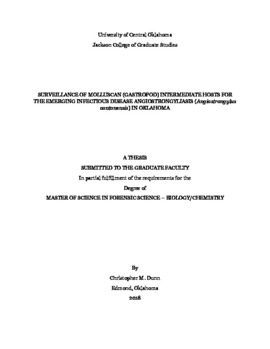| dc.contributor.advisor | Lord, Wayne D. | |
| dc.contributor.author | Dunn, Christopher M. | |
| dc.date.accessioned | 2020-07-09T14:41:44Z | |
| dc.date.available | 2020-07-09T14:41:44Z | |
| dc.date.issued | 2018 | |
| dc.identifier.other | (AlmaMMSId)9982642478702196 | |
| dc.identifier.uri | https://hdl.handle.net/11244/325142 | |
| dc.description.abstract | Angiostrongylus cantonensis, the rat lungworm, is the etiologic agent of an emerging infectious zoonosis, angiostrongyliasis. To date there is relatively little known about this parasite from a public health perspective. Because snails play a critical role in the rat lungworm's life cycle, as intermediate hosts, it is paramount that snail species able to harbor this disease are identified to increase awareness of the geographic spread of this disease locally and globally. Our research aimed to identify the parasite within endemic Oklahoman molluscan intermediate hosts and to provide current geographic distribution within these intermediate hosts. The most abundant aquatic snails and bivalves were collected by hand in southeast Oklahoma between the months of September 2016 and September 2017 (N=351). The sampling resulted in the collection of three species including Physa spp., Planorbella trivolvis and Corbicula fluminea, the Asian clam. Total digestion of tissue was performed before extraction of DNA for each sample. Quantitative polymerase chain reaction (qPCR) was utilized for amplification of the internal transcribed spacer 1 (ITS1) region of A. cantonensis. Melt-curve analysis was implemented with qPCR for secondary confirmation. Further confirmation was performed by resolving all amplified products on an agarose gel via electrophoresis and identifying the presence or absence of a band at the target DNA size belonging to A. cantonensis (267bp fragment). Further optimization was conducted to ensure highest quality of results including temperature gradients, primer concentration gradients, different primer sets (including self-created sets), varying cycle conditions, different modes of PCR such as touchdown-PCR, utilizing intercalating dyes as well as probe-based qPCR, and inclusion of more refined assay components such as a black hole quencher (BHQ). After performing the optimized assay on all 351 collected gastropod samples none yielded positive confirmation of A. cantonensis DNA. These results indicate that Oklahoma creates bottlenecks in many forms such as geographic, climatic and biologic that inhibit the ability of this parasite to gain a foothold beyond southeast Oklahoma. The absence of rat lungworm DNA within the most abundant aquatic intermediate hosts in this region confirm the unsuitability of these species as intermediate hosts for this parasite. | |
| dc.rights | All rights reserved by the author, who has granted UCO Chambers Library the non-exclusive right to share this material in its online repositories. Contact UCO Chambers Library's Digital Initiatives Working Group at diwg@uco.edu for the permission policy on the use, reproduction or distribution of this material. | |
| dc.subject.lcsh | Metastrongylidae | |
| dc.subject.lcsh | Helminths | |
| dc.subject.lcsh | Gastropoda | |
| dc.subject.lcsh | Gastropoda | |
| dc.subject.lcsh | Helminths | |
| dc.subject.lcsh | Metastrongylidae | |
| dc.title | Surveillance of molluscan (gastropod) intermediate hosts for the emerging infectious disease Angiostrongyliasis (Angiostrongylus cantonensis) in Oklahoma. | |
| dc.type | Academic theses | |
| dc.contributor.committeeMember | Creecy, James P. | |
| dc.contributor.committeeMember | Mabry, John P. | |
| dc.thesis.degree | M.S., Chemistry | |
| dc.subject.keywords | Angiostrongylus cantonensis | |
| dc.subject.keywords | Emerging infectious disease | |
| dc.subject.keywords | Nematodes | |
| dc.subject.keywords | Rat Lungworm | |
| dc.subject.keywords | Species identification | |
| dc.subject.keywords | Surveillance | |
| dc.identifier.oclc | (OCoLC)1099799633 | |
| uco.group | UCO - Graduate Works and Theses::UCO - Theses | |
| thesis.degree.grantor | Jackson College of Graduate Studies. | |
